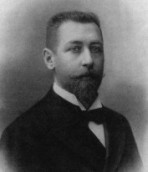Dr Eugène-Louis Doyen Eugene-Louis Doyen
 French surgeon
French surgeon
Of all those of the medical profession who took an early interest in the arrival of moving pictures, none was more enthusiastic or bolder in his use of the new medium than Eugène-Louis Doyen. Struck at an early Lumière show by the possibilities of film, as means of recording his work for educational purposes and of publicising it, he employed Clément-Maurice, organiser of the very first Lumière shows at the Grand Café, and Ambroise-François Parnaland to film and photograph some of his surgical operations. Clement-Maurice had to modify a Cinématographe for the extended filming required and recommended that Doyen operate in the open air on a cadaver. The doctor refused and the operations were filmed under moderate artificial light, with success. Encountering hostility towards his plans in France, Doyen presented the results in Edinburgh to the British Medical Society in July 1898. The exhibition of these films (including a craniectomy and an abdominal hysterectomy) upset many of Doyen's French colleagues, who felt that the integrity of their profession had been violated, but he had much success abroad showing his films at medical conferences. He produced around ten films per year, and in 1902 filmed La Séparation de Doodica-Radica, an operation to separate Siamese twins (successful, although both Doodica and Radica died within a year). Doyen found himself at the centre of further controversy when it was discovered that some of his films were being secretly distributed by Parnaland, with copies turning up at fairground shows. Doyen successfully prosecuted Parnaland (marking an important legal step in recognising film as an artefact meriting legal protection). In 1911 Doyen's collection of films was bought by the Éclipse company, which sold it on to Gaumont after the First World War. Doyen was a celebrated figure who courted both controversy and fame, had a wealthy clientele, a taste for duels and was frequently satirised. However, his interest in the educational power of the cinema was genuine, and included experimention with stereoscopic film (1903), microcinematography (1911) and colour film (1912). His surgical films were parodied by Georges Méliès and others.
Luke McKernan

